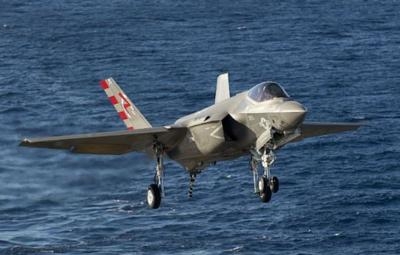But for a Single Error …
On 24 February 2023, the United States Navy (USN) made public its determination that a 2022 accident involving one of the service’s F-35C Lightning II fighter jets was occasioned by a junior flight officer’s failure to complete a requisite landing checklist during a specialized maneuver.

The junior officer’s lapse in judgment precipitated an unfortunate series of events which ultimately sent a $117-million, fifth-generation combat aircraft to the bottom of the South China Sea.
The accident occurred on 24 January 2022 at approximately 16:30 Hotel military time (UTC +8) as the U.S. Navy nuclear aircraft carrier Carl Vinson (CVN-70) was performing flight operations in the South China Sea. While making his first attempt to perform a specialized landing approach to the carrier, the aforementioned junior officer—an unnamed lieutenant assigned to the Argonauts of Strike Fighter Squadron 147—failed to realize a thrust-control subsystem essential to the maneuver had been switched off.
Operating in an underpowered condition, the F-35C struck the aft end of the Carl Vinson’s flight-deck, damaging the great ship to the tune of $120,000. The impact severed the fighter’s main landing-gear and bounced its empennage skyward. The resultant downward movement of the F-35C’s forward section snagged one of the aircraft’s air-to-air missile brackets on the carrier’s arresting-wire, imparting a counterclockwise spin.
Continuing forward under its own momentum, the F-35C burst into flames as it spun across the Vinson’s flight-deck, until it tumbled overboard, the pilot ejecting as the jet plunged into the drink.
Flying debris injured six sailors on-deck and did north of $2.5-million damage to an unlucky EA-18G Growler. The shaken aviator sustained only minor injuries, however, and was plucked expediently from the sea by a Navy helicopter crew.
On 02 March 2022, a team comprising personnel from U.S. Navy Task Force 75 and the Naval Sea Systems Command’s Supervisor of Salvage and Diving (SUPSALV) embarked on the diving support construction vessel (DSCV) Picasso, recovered the F-35C’s wreckage from a depth of approximately 12,400 feet.
In a post-incident report, 7th Fleet Commander Vice Admiral Karl Thomas wrote: "This mishap was the result of pilot error. The mishap pilot (MP) attempted an expedited recovery, breaking overhead the carrier, an approved and common maneuver, but the MP had never performed this maneuver before, and it reduced the amount of time to configure the aircraft and conduct landing checks."
The maneuver the pilot attempted is referred to by Naval Aviators as a Sierra Hotel Break.
During an expedited recovery maneuver, pilots avail themselves of gravity to rapidly decelerate their aircraft during a 360-degree turn. The maneuver reduces the time necessary to recover an aircraft—which is to say, get it safely down on an aircraft carrier’s flight-deck.

While performing subject maneuver, unnamed lieutenant failed to correctly transition from hands-on control of the aircraft to a prerequisite automated mode. Unaware of his mistake, the pilot went on attempting to fly the F-35C manually—albeit with very poor results.
In the wake of the incident and its protracted investigation, Vice Admiral Kenneth Whitesell, commander of Naval Air Forces, made several recommendations, including the development of helmet-mounted and external indicators by which Navy pilots and signal officers may be notified on such instances that landing aircraft have not been switched into the proper automated command modes.
The Field Naval Aviator Evaluation Board’s investigation determined expedited recovery maneuvers ought not be banned insomuch as the January 2022 accident’s primary cause was not the maneuver, but the pilot’s failure to correctly manage his aircraft’s various and sundry technologies.
Unnamed lieutenant—if indeed a lieutenant still—has been removed from Naval flight status but remains in the service—so said an unnamed Navy spokesman.
 ANN's Daily Aero-Term (04.25.24): Airport Rotating Beacon
ANN's Daily Aero-Term (04.25.24): Airport Rotating Beacon ANN's Daily Aero-Linx (04.25.24)
ANN's Daily Aero-Linx (04.25.24) Klyde Morris (04.22.24)
Klyde Morris (04.22.24) Airborne 04.24.24: INTEGRAL E, Elixir USA, M700 RVSM
Airborne 04.24.24: INTEGRAL E, Elixir USA, M700 RVSM Airborne 04.22.24: Rotor X Worsens, Airport Fees 4 FNB?, USMC Drone Pilot
Airborne 04.22.24: Rotor X Worsens, Airport Fees 4 FNB?, USMC Drone Pilot




